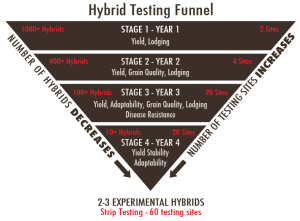 Product Pipeline
Product Pipeline
We’re on a journey to identify the best rice seed product. The goal of our research is to select products that increase value to growers, processors and end-users.
Developing parents is the first step in producing our superior rice seed products. The hundreds of parents we produce result in thousands of trait combinations. Each combination is evaluated against five characteristics: grain yield, milling yield, disease resistance, grain quality and standability. Our breeding work yields a constant supply of top-quality products.
Collaboration with Growers and Processors
Growers participate in shaping RiceTec product offerings by allowing us to put test plots in their fields. This gives growers the ability to observe and experience the new products along with us. Processors have the opportunity to assess our rice grain before they are released to growers. That informs what we can do to improve the product even further. We welcome and encourage input from those buying our rice and record their comments for use in the future.
Innovative
The goal of RiceTec’s Research and Technology team is to increase profitability of rice production for the farmer through the exploitation of heterosis. What is heterosis, you ask? Hybrid vigor describes the increased strength of different traits, the possibility to obtain a genetically superior individual by combining the virtues of its parents. Examples of such exploitation would be superior yield and disease resistance, along with seed specifically formulated to display stable performance in different environments.
RiceTec products are tested across the entire Southern rice market and across multiple years by our own researchers as well as under the careful watch of public collaborators. We estimate that in a single year, the RiceTec yield trial system generates information equivalent to a decade of testing in a traditional rice breeding program. All new products are compared with the best commercial products to ensure that only products with superior grain yield, milling yield, disease resistance, grain quality and standability are introduced to the marketplace.
Research and Technology personnel are located at RiceTec research headquarters in Alvin, Texas; in Harrisburg, Arkansas; and at off-season locations in Puerto Rico, which allow us to grow rice throughout the year.
Technology Based
To create the most value for the farmer, RiceTec invests in cutting-edge technology. As a result, we are able to maintain an in-depth understanding of the rice market and focus attention on the most promising genetic traits. Technology also assists us in rapid introductions of new, better-performing products.
Improvements on the molecular level
RiceTec uses molecular breeding to increase the efficiency and effectiveness of its breeding program. Molecular breeding techniques help us identify the combinations with characteristics desired by the marketplace.
Accelerated breeding
Using plant tissue, locations in the chromosome (normally called markers) are traced in the laboratory. Traits normally measured at later development stages can be identified earlier, enhancing breeding efficiency and speed. Thus we can incorporate a specific trait into a parent much faster than conventional breeding alone and with a more predictable outcome. Molecular breeding techniques enable us to reduce parent development time by five to six plant generations (two to three years).
FAQ
What is disease resistance?
Disease resistance is the ability to minimize the yield effects of common rice diseases.
What is grain quality?
Grain quality refers to grain appearance and cooking properties. These include length, width, transparency, water absorption, cooking time and texture.
What is grain yield?
Grain yield is the amount of grain produced in the field.
What is milling yield?
Milling yield is the amount of grain remaining after the grain has been milled.
What is standability?
Standability is the ability to produce and hold increasingly heavier loads of grain without the plant falling to the ground.